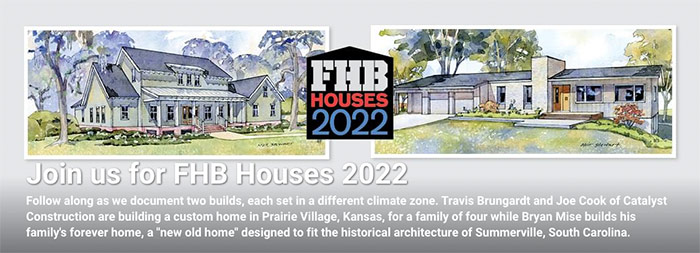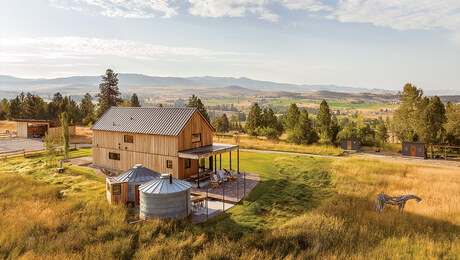Podcast 549: Energy Upgrades, Chimney Inspections, and Questions About a Home You Might Buy
Anvils, vapor control, subfloor air barriers, chimney inspections, and questions for home sellers.
Follow the Fine Homebuilding Podcast on your favorite app. Subscribe now and don’t miss an episode:
 |
Help us make better episodes and enter for a chance to win an FHB Podcast T-shirt:
www.finehomebuilding.com/podcastsurvey
Mike has advice about anvils. Domas clarifies Canadian code on interior poly sheeting. Nicky asks about improving airtightness. Sam asks if a chimney cleaning is the same as a chimney inspection. A prospective home buyer wonders what questions to ask sellers about a home you’re considering buying. The crew contemplates old-house features.
Editor Updates:
- Mike: snowboarding and flagstone
- Ian: trip back East
Listener Feedback 1:
Mike writes: Hi Patrick,
I have a couple further items for you. First, you’ve often mentioned your early days with Habitat for Humanity and a current curiosity about the RV Care-A-Vanners in your dotage. Like you, I’ve done Habitat builds periodically over many years, particularly when I ran out of ideas for projects on my own house. Now I have more time, so I joined the Care-A-Vanners. They not only help local affiliates who can’t fully staff a build, but most of us are also fairly experienced and can add particular expertise that might be unavailable locally. When natural disasters strike, HFH’s CAV (as they call themselves) do not do cleanup, but they come in afterward and can provide a reliable team of builders over a longer period to get the rebuilding work done. Your pondering of retirement options mentioned the CAV. Your expertise would be a real asset to the them.
Second, back when Rob was on the show, I enjoyed his stories of his metalwork pursuits. I have monkeyed around with blacksmithing for a long time but took it up seriously after I retired. My present smithy is quite enviable. When I heard you trying to convince Ian to come help you put your anvil up on a top shelf, I almost drove off the road. No anvil should go unused. It’s a beautiful tool, and there are many young smiths searching for a good anvil. In the spirit of “keeping craft alive,” you should put it in the hands of someone who will use it.
Also, to put an anvil on a top shelf is an accident waiting to happen. You didn’t say specifically how heavy it is, but based on your description of the come-along concept you were going to deploy to get it up there, my guess is that it’s +100 lbs. At best, it will sag any shelf you put it on; at worst, it will cause the shelf to fail and it will end up on your head. End of Patrick. And we don’t want that.
Sorry it ran on into a short story, but now you know the rest of the story.
All the best to you and the podcast crew.
Now where was I? Rest stop. Somewhere in North Carolina…
Related Links:
Listener Feedback 2:
Domas in Newfoundland writes: Hi Patrick,
Thanks for bringing my question to your discussion. I’m afraid I haven’t explained my issue well enough, and I’d like to clarify—not to continue this conversation, but mainly for my personal peace of mind.
Building with two barriers isn’t really a choice for us, as you guys might have assumed. We choose to put effort into exterior barriers to make buildings better. We have to do 6-mil poly to satisfy code. We could neglect one of the barriers to save cost and time and still have a passable result, but that doesn’t feel right. Next thing you know we’ll have a workplace run by a spreadsheet. Therefore, we do both as best as we can—and look crazy. I would ditch 6-mil poly in a heartbeat if I could.
Thanks for hearing me out.
Kind regards,
Domas
Related Links:
Question 1: How do I get close to passive-house levels of airtightness?
Nicky writes: Hi Patrick,
I enjoyed listening to the latest episode with Zac, as I’ve been living in NZ for a while now and became a licensed sparky (electrician) and HVAC installer.
I lived in Queenstown for a few years, which is a dry climate, but I’ve now moved 3 hours east to Dunedin, which is a coastal climate and wet. And it’s true the building here is quite behind the rest of the world.
My goal is to make this house close to a passive house (it doesn’t have the orientation to achieve it completely).
Now to the question. I would like to renovate an old 1905 bungalow villa style (I think). I will be reusing the old wood T&G flooring (I hope), because it has character. But my idea was to take the flooring out, level out the beams as much as possible, put 20-mm (+- 3/4) OSB down (screwed and glued with seams taped as it will become floor air barrier), put down 7-mm plywood (little under 3/8), glue the wood flooring down to the 7-mm ply, and then staple the flooring down. This is because I would like to achieve a base in case I will be ripping the floor out in 30 years’ time.
 |
 |
 |
 |
 |
Also, I would like to install GIB plasterboard on the walls, but I’m afraid rot could happen because the exterior weatherboards don’t have a cavity and building paper behind them due to restriction of airflow and won’t be able to dry out. I have located power point switches, etc., so that they won’t fall on an exterior wall to give a continuous air barrier.
Also, in about five years we will be tackling the exterior by going with Joseph Lstiburek’s “Perfect Wall” assembly—plywood on the exterior, peel-and-stick membrane. exterior insulation, then cavity etc. This will go up the roof as well, although because most attics are vented in NZ they will call me crazy here.
Sorry for the long note.
Thank you for your time and hours of podcast listening. I have been with you from the start and plan to keep listening as there is always something to gain.
Please don’t hesitate if you need more photos and information.
Related Links:
- Crash Course in Control Layers
- Joe Lstiburek’s Ideal Double-Stud Wall
- Joe Lstiburek’s “Perfect Wall” explained—The 500 Year House
Question 2: What’s the difference between a chimney inspection and a chimney cleaning?
Samantha writes: When I first bought my house, I tried to get a chimney inspection, but I think I ended up with just a sweeping? I’m not exactly sure how to know. What’s the difference—they send a camera up to check the flue liner vs. they just vacuum it out? Is there a difference, and what value do each of those services bring? Have I been swindled?
Related Links:
Question 3: What questions should first-time home buyers ask?
A home-buying newbie writes: What kinds of questions should prospective first-time home buyers be asking? There’s so much you don’t know to ask about (like property lines and easements and restrictions). How do people equip themselves to make a smart and informed purchase?
Related Links:
- Podcast 527: Members-only Aftershow—Educating new home buyers
- What to Look for When Buying an Old House
- New Homes: 9 Things You Don’t Need, and 5 You Do
Question from the crew— Old-house features?
What cool things are found in old houses that you don’t see anymore? Are there things that you’ve seen go out of fashion only to come back again?
Related Links:
- 14 Old Home Features Most People Don’t Use Anymore
- Where Have the Details Gone?
- A Look Back: Why We Build the Way We Do
END NOTES:
Podcast 549: Members-only Aftershow — Patios vs. Decks
Ian, Mike, and Patrick talk about building and living with decks and patios and why you might choose one over the other.
Check out one of our latest Project Guides: Energy Retrofit!
Check out our FHB Houses:
Visit the Taunton Store • Magazine Index • Online Archive • Our First Issues • All Access
Help us make better episodes and enter for a chance to win an FHB Podcast T-shirt: www.finehomebuilding.com/podcastsurvey

If you have any questions you would like us to dig into for a future show, shoot an email our way: fhbpodcast@taunton.com.
If we use your question we’ll send you a FHB Podcast sticker!
FHB Podcast T-shirts!
Represent your favorite podcast! Available in several styles and colors. Made from 100% cotton. Find the Podcast t-shirt and more cool products in the Fine Homebuilding Store.
| Fine Homebuilding podcast listeners can now get 20% off anything in the Taunton store, including Pretty Good House.
Use the discount code FHBPODCAST to take advantage of this special offer. |
 |
“Finally, knowledgeable people talking about building reasonably-sized, high-performance houses for normal people with real budgets!” — DanD, VA, 8/19/22, Amazon.com review |
We hope you will take advantage of a great offer for our podcast listeners: A special 20% off the discounted rate to subscribe to the Fine Homebuilding print magazine. That link goes to finehomebuilding.com/podoffer.
The show is driven by our listeners, so please subscribe and rate us on iTunes or Google Play, and if you have any questions you would like us to dig into for a future show, shoot an email our way: fhbpodcast@taunton.com. Also, be sure to follow Fine Homebuilding on Instagram, and “like” us on Facebook. Note that you can watch the show above, or on YouTube at the Fine Homebuilding YouTube Channel.
The Fine Homebuilding Podcast embodies Fine Homebuilding magazine’s commitment to the preservation of craftsmanship and the advancement of home performance in residential construction. The show is an informal but vigorous conversation about the techniques and principles that allow listeners to master their design and building challenges.
Other related links
-
- All FHB podcast show notes: FineHomebuilding.com/podcast.
- #KeepCraftAlive T-shirts and hats support scholarships for building trades students. So order some gear at KeepCraftAlive.org.
- The direct link to the online store is here.


































